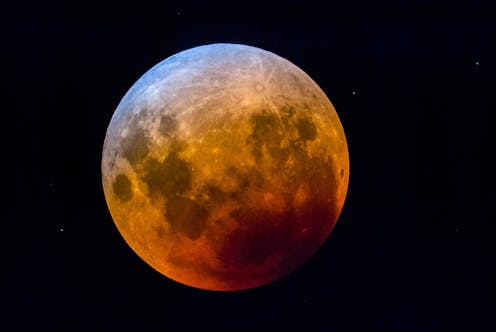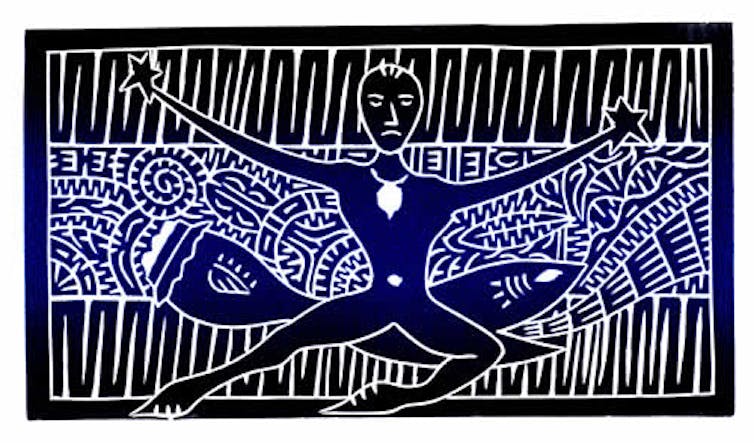Source: The Conversation (Au and NZ) – By Duane Hamacher, Associate Professor, The University of Melbourne

It’s eclipse season. The Sun, Earth and Moon are aligned so it’s possible for the Earth and Moon to cast each other into shadow.
A faint lunar eclipse will occur on March 25, visible at dusk from Australia and eastern Asia, at dawn from western Africa and Europe, and for much of the night from the Americas. Two weeks later, on April 8, a total solar eclipse will sweep across North America.
These events are a good time to think about an infamous incident 520 years ago, in which an eclipse prediction was supposedly used to exploit an Indigenous population. The incident has shaped how we think about astronomy and Indigenous cultures – but the real story is far more complex.
Read more:
How eclipses were regarded as omens in the ancient world
Columbus and the eclipse
In June 1503, on his fourth voyage to the Americas, Italian explorer Christopher Columbus and his crew became stranded on Jamaica. They were saved by the Indigenous Taíno people, who gave them food and provisions.
As months passed, tensions grew. Columbus’s crew threatened mutiny, while the Taíno grew frustrated with providing so much for so little in return. By February, the Taíno had reached their breaking point and stopped providing food.
Supposedly, Columbus then consulted an astronomical almanac and discovered a lunar eclipse was forecast for February 29 1504. He took advantage of this knowledge to trick the Taíno, threatening to use his “magic power” to turn the Moon a deep red – “inflamed with wrath” – if they refused to provide supplies.

Astronomie Populaire (1879) by Camille Flammarion, via Wikimedia
According to Columbus, this worked and the fearful Taíno continued to supply his crew until relief arrived months later. This incident inspired the idea of the “convenient eclipse”, which has become a familiar trope in works including Mark Twain’s A Connecticut Yankee in King Arthur’s Court (1889) and The Adventures of Tintin (1949).
But is there truth to the trope? How much did Indigenous peoples really know about eclipses?
Merlpal Maru Pathanu
In the Torres Strait, knowledge of the stars is central to culture and identity. Traditionally, special people were chosen for years of intense instruction in the art of star knowledge, which occurred in a secretive place of higher learning called the kwod. They would be initiated as “Zugubau Mabaig”, a western Islander term meaning “star man” – an astronomer.

David Bosun
Mualgal man David Bosun, a talented artist and son of a Zugubau Mabaig, explains that these individuals paid careful attention to all things celestial. They kept constant watch over the stars to inform their Buai (kinship group) when to plant and harvest gardens, hunt and fish, travel and hold ceremonies.
Read more:
A shark in the stars: astronomy and culture in the Torres Strait
The final stage of Zugubau Mabaig initiation involved a rare celestial event. Initiates were required to prove their bravery as well as their mental skill by taking the head of an enemy, particularly a sorcerer. In this way they would absorb that person’s powerful magic.
Headhunting raids occurred immediately after a total lunar eclipse, signalled by the blood red appearance of the Moon. During the eclipse, communities performed a ceremony in which dancers donned a special dhari (headdress) as they systematically chanted the names of all the surrounding islands.

National Gallery of Australia
The island named when the Moon emerged from the eclipse was the home of the sorcerers they planned to attack. Women and children sought shelter while the men prepared for war. The ceremony, named Merlpal Maru Pathanu (“the ghost has taken the spirit of the Moon”), was planned well in advance by the Zugubau Mabaig.
How was this done?
Predicting an eclipse
The Moon does not orbit Earth in the same plane Earth orbits the Sun. It’s off by a few degrees. The position of the Moon appears to zigzag across the sky over a 29.5-day lunar month. When it crosses the plane connecting Earth and the Sun, and the three bodies are in a straight line, we see an eclipse.
We know that ancient cultures including the Chinese and Babylonians possessed the ability to predict eclipses, and it is rather difficult to do. How did the Zugubau Mabaig accomplish it?
Read more:
The Memory Code: how oral cultures memorise so much information
There are some things they would know. First, lunar eclipses only occur during a full moon, and solar eclipses during a new moon.
Second are the “eclipse seasons”: times when the planes of Earth, Moon and the Sun can intersect to form an eclipse. This happens twice a year. Each season lasts around 35 days, and repeats six months later.
Third is the Saros cycle: eclipses repeat every 223 lunar months (approximately 18 years and 11.3 days).
The details are highly complex. But it’s clear that predicting an eclipse requires careful, long-term observations and keeping detailed records, skills Torres Strait Islander astronomers have long possessed.
Flipping the narrative
The Zugubau Mabaig eclipse forecasts turn a common understanding of the history of science on its head. Indigenous peoples did, in fact, develop the ability to predict eclipses.
Perhaps the real situation is better captured in a short story called El Eclipse (1972), by Honduran writer Augusto Monterroso.
In the story, a Spanish priest is captured by Maya in Guatemala, who opt to sacrifice him. He tries to exploit his knowledge that a solar eclipse will occur that day to trick his captors, but the Maya look at the priest with a sense of incredulity. Two hours later, he meets his fate on the altar during the totality of the eclipse.
As the Sun goes dark and the priest’s blood is spilled, a Maya astronomer recites the dates of all the upcoming eclipses, solar and lunar. The Maya had already predicted them.
The truth behind this story is found in the Dresden Codex, a thousand-year-old book of Maya records that includes tables of eclipse predictions.
Learn more at www.aboriginalastronomy.com.au
![]()
Duane Hamacher received funding from the Australian Research Council, the Laby Foundation, the Indigenous Knowledge Institute, and the University of Melbourne.
David Bosun does not work for, consult, own shares in or receive funding from any company or organisation that would benefit from this article, and has disclosed no relevant affiliations beyond their academic appointment.
– ref. ‘The ghost has taken the spirit of the Moon’: how Torres Strait Islanders predict eclipses – https://theconversation.com/the-ghost-has-taken-the-spirit-of-the-moon-how-torres-strait-islanders-predict-eclipses-226005








